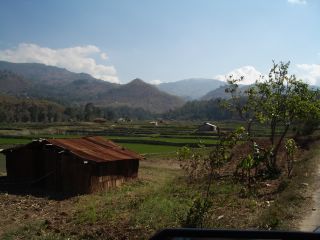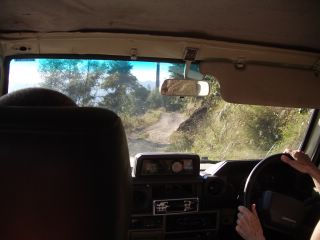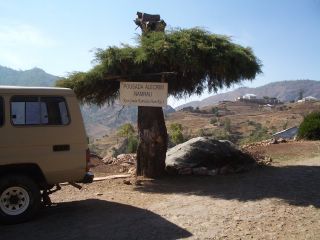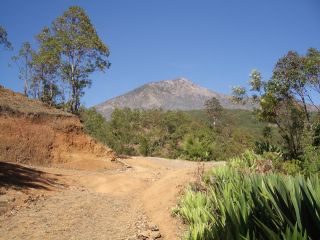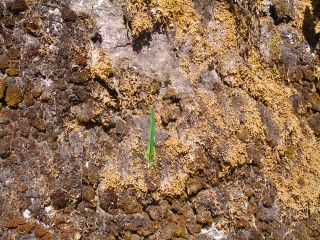Hatubuilico and Mount Ramelau
Friday 30 September was another public holiday but this time only for Dili to allow its residents to vote for their “xefi sucos” (village chiefs or mayors). Eager for any excuse to get out of the capital, after lunch, along with another AVIer we headed south to the village of Hatubuilico the base for climbing Gunung Tatamailau (Mount Ramelau), at 2963 meters, the highest peak in Timor. On the way, we collected another AVIer in Aileu. Both AVIers were the ones we originally came to Timor with. The trip was ostensibly to celebrate our first three months in Timor.
Hatubuilico is southwest of Dili and part of the Mambae (dialect) region. It took us 5 hours to drive the 100km distance to Hatubuilico. The final 18km was along a very narrow and windy gravel road where our speed slowed down to 5-10km an hour. As a result, it took about 1.5 hours to drive a mere 18km! After about 12km, we turned off onto the wrong road and ended up trying in vain to drive up a muddy strip of a path but the 4WD didn’t like it one bit. There were two Timorese men herding their water buffalo and so we got out of the car and asked them the direction to Hatubuilico. It turned out that we had driven off the main road and had to backtrack a few hundred metres. In appreciation, we gave the old man two cup cakes purchased in Aileu which he seemed very pleased with given his big toothless smile. We hoped he would give one to his younger comrade but weren’t too sure this would happen as all the way along the 18km stretch of road, little children would come running out of their traditional thatched roof houses shouting “agua” (water) or “dosi” (sweet cakes) at us. We hoped it wasn’t what we suspected, that given the dry and hungry seasons, the children were in fact very thirsty (and hungry) and wanted at the very least, water from us. Unfortunately, we couldn’t give them any on the way up but on our return trip we gave away what little we had left.
We spent the night in the pousada at Hatubuilico; a lovely little place which only opened two years ago. It is owned and run by a man called Alex who is also in charge of secondary education for the district of Ainaro. He is fluent in both English and Portuguese (in addition to Tetun, Bahasa and Mambae) and had many books in his office. I asked him where he learned English and he said in a seminary in Dili. He would have been one of the 15% of Timorese who were educated under Portuguese rule, of which only 5% are still alive today.
We had purchased food from one of the three supermarkets in Dili that morning, so had a luxurious Western feast for dinner consisting of multigrain bread imported from Malaysia, cheese from New Zealand, olives from Spain, vegemite from Australia, red capsicum from goodness knows where and Belgian chocolate chip biscuits from England. Not one skerrick of Timorese food, which was what one of our companions wanted during the trip (she is heartedly sick of white rice and slimy green vegetables grown in the sewers of Dili). We went to bed early and for the first time since arriving in Timor, had to sleep with blankets! I had two on my bed and was still so cold that I did not sleep very well.
The following morning for breakfast, two young girls (Alex’s daughters) served us breakfast: coffee and shallow fried sweet dough like greasy hard bread. I don’t drink coffee so had a few pieces of the bread which weren’t too bad but decided to also open a can of peaches from Australia (how I miss stone fruits and berries). We then prepared ourselves to leave for the big climb up Mount Ramelau.
At 9:20am, at a meadow at 2280m we commenced the walk. Near the beginning of the walk, we saw about seven ponies and then passed through a eucalypt forest. In fact, the only trees growing on the mountain appeared to be eucalypt and wattle so you could be mistaken for bushwalking in Australia. There were some birdcalls but we could not spot the owners, but closer to the top a flock of swifts guided our way.
At about two-thirds the way up, the back of my heel on my left foot was in a lot of pain and I knew I had a blister. We stopped and I discovered no blister but a very red raw patch of new skin as I had rubbed off the top layer. I put a bandaid on. Unfortunately, the bandaid then moved inside my sock and the pain started again. We stopped again, and this time Daniel put on elastoplast kindly given to us by one of our companions. I also put on her socks underneath mine to give more padding to my heels. As we took off again, we had our first fall, as one of our companions fell flat on her face trying to scramble up some very slippery rocks. A little further on, we felt our blood sugar levels falling and stopped to have a snack of strange tasting vegetable biscuits from China (with no translation of ingredients into English, Daniel could only make out some of the Chinese characters) and muesli pieces from New Zealand. We soldiered on under a cloudless bright blue sky and piercing sun with great views south to the ocean.
After our snack, we came across the most perilous part of the journey: a narrow path, strewn with slippery rocks, with much evidence of recent landslides that had been patched up (and you wouldn’t want to test the patches) combined with strong cold gusty winds that we thought would knock us off the side of the mountain. Most of this path was incredibly steep and we wondered how we would ever get down again. We finally came across a flat meadow where outdoor religious ceremonies are held twice a year on 13 October and 13 May to celebrate “Nossa Senhora de Fatima” (Our Lady of Fatima) (further details below). It was here that one of our companions decided to call it quits as she was exhausted. It was another 20-30 minutes to the top and I just decided I hadn’t come this far without getting to the highest point in Timor, so Daniel and I pushed on ahead. Meanwhile, our other companion was already at the top of Mount Ramelau.
The view at the top was marred by poor visibility but we could see down to the south coast. On a good day, you can see all the way to the north coast and Atauro Island as well (we have since been told that in the dark, the lights of Darwin can also be seen). The three of us stopped for a good hour and ate the rest of our food (almonds from who knows where, dried fruit from Australia). We had also just about finished our 1.5 litre bottles of water. I put a knee brace on my right knee in preparation for the return journey, as I knew it would be far tougher than the ascent. I have one leg shorter than the other (you’d never notice) which puts pressure on my right knee when walking down mountains and at times, has caused me excruciating pain. We took a couple of photos with the Virgin Mary and then started our descent at around 3pm.
Our companions walked ahead of us while Daniel had to slow down for me as very quickly I felt the pain in my right knee and began to compensate by putting more pressure on the left side of my body. I soon found two broken off branches of a wattle tree and used these like ski poles to take pressure off my knees. However, due to the steepness of the descent, we were soon walking sideways very slowly, and at times, getting down onto our bottoms. It was incredibly slippery with all the rocks, which slowed us down further. I spent most of the climb down walking sideways, which of course, makes for very slow going. About half an hour from the end, I fell over on some slippery rocks and crash-landed on my bottom. It was very difficult to get up, as I could not bend my right knee due to the brace. Soon after this little incident, one of our companions came back up the mountain to look for us. Our companions were very worried as they had been back at the car for nearly two hours with no sign of us. One of them had tried to call us but as there was no mobile phone reception, could not get through. They were on the verge of calling customer care (our medical insurers) in Australia!
We had been gone so long that Alex rode out on his motorcycle to see if we were okay. Thankfully, he came just as we were approaching our final 5 minutes of the walk down. We finally made it to the bottom of the mountain at 7pm; a very long and tiring four-hour return journey. All up, we had walked seven odd hours although our companions did it in less time. We discovered one of them had also fallen over on her way down the very dangerous section and ended up with a large purple bruise on her upper right thigh, much like the one I sustained when hit by the door of the "mikrolet". Daniel was the only one not to have a tumble although he ended up with sunburn on his arms and the back of his neck.
We were all exhausted. When we arrived back at the pousada, a plate of small greasy chips were waiting for us. Unfortunately, they were cold as I expect Alex thought we would return sooner. Three of us decided to order some dinner from Alex’s family and in due course, were served with white rice, snow peas and very spicy noodles, and a very hot and spicy side dish consisting of onions, garlic, chili and a green herb or vegetable. We also opened a can of baked beans from Australia and I ate them cold with the rice and vegetables in order to drown out the spiciness. We also ate more of the multigrain bread, cheese and vegemite. We opened a bottle of chardonnay from Australia (the only cold thing we had apart from beer which I don’t like) and drunk it with dinner. For dessert, we had the Belgian chocolate chip biscuits from England. We were so tired and the water in the “mandi” so cold that we decided to go to bed unwashed. I put another very heavy blanket on my bed so now I had three, but soon discovered I was now too hot! I got rid of the other two blankets but I was so sore from the climb that I didn’t sleep well yet again.
The following morning we were served coffee and cooked taro, neither of which I touched. Our companions took one bite of the taro and promptly ate something else: more multigrain bread and vegemite and the last of the tinned peaches (oh how I love Western food!). The water was still so cold in the “mandi” that I refused to wash while everyone else did a mini wash for as long as they could bear the cold.
We said our goodbyes to Alex and paid him $10 a night each plus $1 for breakfast each and $3 for dinner each and began the long journey home. Along the 18km road out of Hatubuilico we gave away our remaining water and some sweet biscuits for good measure to some of the many children who approached us. If ever I return to the village during the wet and hungry seasons, I will buy extra water beforehand to give away to the children.
Lonely Planet’s description of the climb up Mount Ramelau is deceptive. They make it sound very easy when in fact it is not. It is a difficult climb and they should say so along with warnings about slippery rocks and landslides. It took us twice as long to get up and down as the book says it should (7 versus 3 hours). Granted I’m a slow and steady-she-goes kind of gal with a one leg short problem but really, 3 hours up and back!
Our companions walked ahead of us while Daniel had to slow down for me as very quickly I felt the pain in my right knee and began to compensate by putting more pressure on the left side of my body. I soon found two broken off branches of a wattle tree and used these like ski poles to take pressure off my knees. However, due to the steepness of the descent, we were soon walking sideways very slowly, and at times, getting down onto our bottoms. It was incredibly slippery with all the rocks, which slowed us down further. I spent most of the climb down walking sideways, which of course, makes for very slow going. About half an hour from the end, I fell over on some slippery rocks and crash-landed on my bottom. It was very difficult to get up, as I could not bend my right knee due to the brace. Soon after this little incident, one of our companions came back up the mountain to look for us. Our companions were very worried as they had been back at the car for nearly two hours with no sign of us. One of them had tried to call us but as there was no mobile phone reception, could not get through. They were on the verge of calling customer care (our medical insurers) in Australia!
We had been gone so long that Alex rode out on his motorcycle to see if we were okay. Thankfully, he came just as we were approaching our final 5 minutes of the walk down. We finally made it to the bottom of the mountain at 7pm; a very long and tiring four-hour return journey. All up, we had walked seven odd hours although our companions did it in less time. We discovered one of them had also fallen over on her way down the very dangerous section and ended up with a large purple bruise on her upper right thigh, much like the one I sustained when hit by the door of the "mikrolet". Daniel was the only one not to have a tumble although he ended up with sunburn on his arms and the back of his neck.
We were all exhausted. When we arrived back at the pousada, a plate of small greasy chips were waiting for us. Unfortunately, they were cold as I expect Alex thought we would return sooner. Three of us decided to order some dinner from Alex’s family and in due course, were served with white rice, snow peas and very spicy noodles, and a very hot and spicy side dish consisting of onions, garlic, chili and a green herb or vegetable. We also opened a can of baked beans from Australia and I ate them cold with the rice and vegetables in order to drown out the spiciness. We also ate more of the multigrain bread, cheese and vegemite. We opened a bottle of chardonnay from Australia (the only cold thing we had apart from beer which I don’t like) and drunk it with dinner. For dessert, we had the Belgian chocolate chip biscuits from England. We were so tired and the water in the “mandi” so cold that we decided to go to bed unwashed. I put another very heavy blanket on my bed so now I had three, but soon discovered I was now too hot! I got rid of the other two blankets but I was so sore from the climb that I didn’t sleep well yet again.
The following morning we were served coffee and cooked taro, neither of which I touched. Our companions took one bite of the taro and promptly ate something else: more multigrain bread and vegemite and the last of the tinned peaches (oh how I love Western food!). The water was still so cold in the “mandi” that I refused to wash while everyone else did a mini wash for as long as they could bear the cold.
We said our goodbyes to Alex and paid him $10 a night each plus $1 for breakfast each and $3 for dinner each and began the long journey home. Along the 18km road out of Hatubuilico we gave away our remaining water and some sweet biscuits for good measure to some of the many children who approached us. If ever I return to the village during the wet and hungry seasons, I will buy extra water beforehand to give away to the children.
Lonely Planet’s description of the climb up Mount Ramelau is deceptive. They make it sound very easy when in fact it is not. It is a difficult climb and they should say so along with warnings about slippery rocks and landslides. It took us twice as long to get up and down as the book says it should (7 versus 3 hours). Granted I’m a slow and steady-she-goes kind of gal with a one leg short problem but really, 3 hours up and back!
Above: More views over the rice paddies.
Above: On the road with our intrepid friends along what might be a walking track in most of Australia.

Above: It is hard to really get your head around how hilly Timor is until you spend some time actually imagining how you would walk from one point to another.


Above: It is hard to really get your head around how hilly Timor is until you spend some time actually imagining how you would walk from one point to another.

Above: The man who was good enough to tell us we were going the wrong way, saving us much time, trouble and a possible bogging. He was well rewarded with a cupcake.
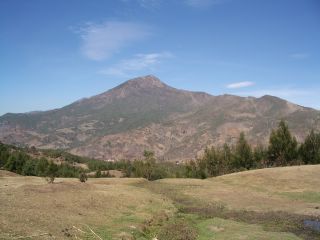
Above: The mountain from afar, perhaps not as spectacular as some - but within Timorese culture Mt Ramelau is one of the prime "fatin luliks" or places of deep spiritual significance and taboo. It seemed to me (Daniel) that the "malae" habit of climbing it without good reason was thought to be a little frivilous (and dangerous) by some.

Above: Hatubuilico.


Above: The mountain from afar, perhaps not as spectacular as some - but within Timorese culture Mt Ramelau is one of the prime "fatin luliks" or places of deep spiritual significance and taboo. It seemed to me (Daniel) that the "malae" habit of climbing it without good reason was thought to be a little frivilous (and dangerous) by some.

Above: Hatubuilico.

Above: Hatubuilico's school, doubling as public space.

Above: More of the scattered homes of Hatubuilico.

Above: A rogue bonsai bathed by the morning sun.

Above: Waterwise Timor hasn't started up in Hatubuilico yet - this tap flowed the whole time we were here. Hopefully fed from some inexhaustible supply!
Above: Even in town there is no easy way to get from point A to B.
Above: More views around town, here the effects of erosion are evident in the deep gorges formed even by a small (in the dry season anyway) creek.


Above: An unfinished grotto with a plaque inscribed by Bishop Belo, but as yet unfurnished with its central object of worship.
Above: An example of Timor's unproductive soils, also reminiscent of the red clays of Australia.
Above: As in any country town, water buffalo wander freely.

Above: The pousada Alecrim Namrau, where we stayed.

Above: The other gig in town. The older and more spectacular of the two pousadas in Hatubuilico, the "blue roof" pousada wasn't open when we passed through.

Above: This was the sitting room in the pousada and it roughly models other arrangements we have seen in the more affluent Timorese homes. I'm not quite sure where to start?
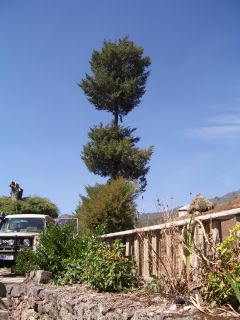

Above: An absolutely marvellous tree next to our "fatin tobar" (sleeping place).
Above: Another intersting tree doubling as the signpost to where we stayed. It is lovely to see the inclusion of a street address on the sign just in case we became confused about which of the many roads the pousada was located on. (There is only one if you don't count the track to the church.)
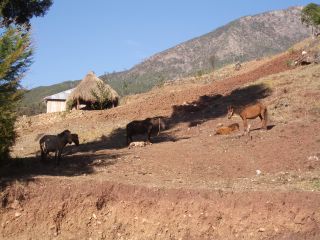
Above: A few of the many Hatubuilico ponies with foals.


Above: A few of the many Hatubuilico ponies with foals.

Above: The early parts of the path, quite civilised really.
Above: Timorese ponies.
Above: Ramelau was visible for most of the trek.
Above: Another dramatic peak visible for most of the trek. In a lot of ways more dramatic than Ramelau, somehow reminiscent of an animal of some kind.
Above: While the photo doesn't really show it, at this point we could see all the way to Suai and the south coast. Wide empty riverbeds were visible winding their way to the sea.
Above: Sam rounds a corner with the view south sprawling behind her.

Above: Some hillsides were littered with dead and dying trees like this one.


Above: Some hillsides were littered with dead and dying trees like this one.

Above: One of the steep sections, but thankfully one with decent footholds.

Above: Familiar trees in an unfamiliar country.


Above: Familiar trees in an unfamiliar country.

Above: This scene shows how much Australia and Timor share in terms of landscape and vegetation. Parts of the climb up Ramelau had me (Daniel) thinking I was bushwalking somewhere in the Snowy Mountains. This is near the high meadow where church services are held.


Above: The open air church and pilgrimage site.
Above: A feather placed by some unknown hand in a wall of moss. Can anyone identify the feather? Let us know.
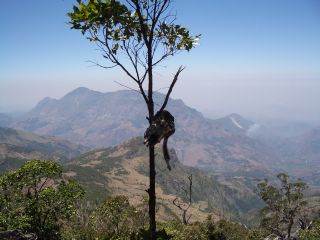

Above: A somewhat ominous sign as you wind the windy paths towards the pinnacle of Ramelau.
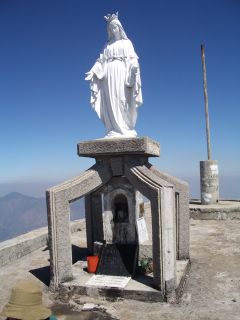
Above: Whilst Mary remains a deeply conflicted symbol within a religion capable of as much hatred as compassion - I couldn't help but feel her extended arms are asking merely for the latter.


Above: Whilst Mary remains a deeply conflicted symbol within a religion capable of as much hatred as compassion - I couldn't help but feel her extended arms are asking merely for the latter.

Above: Yum! Taro for brekkie!
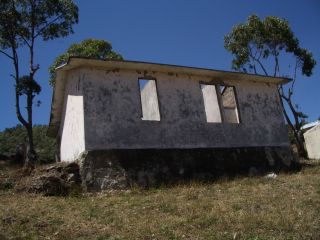
Above: Wherever you go in Timor, burned out shells of buildings are ubiquitous. This is one of many standing by the road back to Dili.

Above: Wherever you go in Timor, burned out shells of buildings are ubiquitous. This is one of many standing by the road back to Dili.
We returned to Dili at around 5pm and that night Daniel and I watched The Bear Cub, a very engaging film about a gay bear man who looks after his nephew and the changes that relationship brings to his life. It was wonderfully acted with a great storyline. I highly commend it.
On Monday night at round 7:30pm, about 50 odd local people holding candles and singing a song made their way down our street and into the home of our family at the back. For the next hour, they sang Ava Maria, and said prayers. A similar number of people did the same with the family across the road (you know the ones). I was intrigued and thought that perhaps someone had died. Daniel and I began to recall which members of the family we had seen that morning and hoped that everyone was okay.
The following morning we went to ask Senyora Domingas if anything was wrong and what the ceremony last night was about. She said nothing was wrong and that the ceremony was for “Nossa Senhora de Fatima” (Our Lady of Fatima). I got out my Lonely Planet East Timor Phrasebook and looked up “Loron Boot” (Festivals & Holidays, literally big days). I suspected that this might be what the celebration was about as soon as Senyora showed us the shrine to the Virgin Mary and all the offerings on the table in their lounge room. This Catholic day celebrates the apparition of the Virgin Mary to three children in Fatima in Portugal on 13 May and 13 October. On these two days, thousands of Timorese walk up Mount Ramelau in the dark (in their thongs), to witness the dawn alongside the three metre statue of the Virgin Mary. I thought it ironic that we had done this climb ourselves so close to the actual day. Every night people will move the Virgin Mary to another home in the neighbourhood and this will continue throughout the month of October. They appear to have bypassed our home knowing that we’re “malae” and probably not Catholic (they’re correct!).
We’re both still suffering from the walk up Mount Ramelau. The left side of my body feels like it has endured a stroke (remarkably, my right knee is pain free), and Daniel is enduring the consequences of his sunburn. As a result, we are catching taxis again until such time as we feel 100% okay. I’m also experiencing my fourth health issue since arriving in Timor; this time it’s an anal fissure (very painful), diagnosed from a search on the Internet and caused I believe from bouts of diarrhoea alternating with constipation (due to a change in diet) and perhaps some dehydration (although I drink two litres of water a day). I will have to search out some bulking agents from the supermarket or chemist this weekend and just hope something is available. I’m doing my best to eat wholegrain products (brown rice, brown pasta, multigrain bread and crackers) imported from Germany, Malaysia and Australia but I do wonder about the Timorese and their very high processed carbohydrate diet. Surely, they must suffer from poor health (they do, as malnutrition, particularly in children is widespread). In addition, they rarely drink any water. Very few of my colleagues drink throughout the day and I understand that kidney problems are an issue here as well. The conjunctivitis in my left eye has made a comeback (maybe it never fully went away) so I’m self medicating again although contemplating making an appointment with Dr Mark at the Australian Embassy compound. However, I feel as if I’m beginning to sound like a hypochondriac but I have never suffered from so many health complaints one after the other!
One of my “malae” colleagues from Germany was so ill after only four months living here that he returned to Germany in mid August for tests and treatment as nothing could be done for him in Timor or Indonesia. We are still waiting to see whether he will return or not. Another AVIer in his mid 50s has had stomach and bowel problems that appear to be like gardia but no amount of treatment will cure him and he regularly has to make trips back to Australia. He now has a heart condition (maybe angina) and he and his wife have decided to leave Timor six months short of their two-year contract. There is no cardio specialist in Timor and taking one day to reach facilities by flying to Australia versus less than hour living in Australia, is enough incentive for them to return home. An Australian English teacher who teaches my colleagues has just been diagnosed with malaria. These are just a few examples of the health problems suffered by “malae” in Timor. As AVI tell us, the two biggest challenges facing volunteers no matter what country they’re in are health and language related. I completely concur.
Category: Timor-Leste (East Timor)


